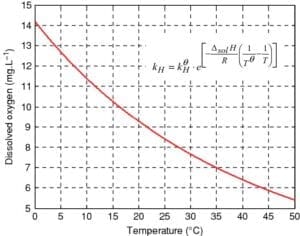Receive Free Shipping On All Orders $75 or More
Receive Free Shipping On All Orders $75 or More

Air Derived Saturation in mg/l (ppm)

In Summary: Air = ~21% Oxygen
Air derived saturation = ~8.4 mg/l Oxygen @25°C
Various studies dating back to the 1970’s and earlier have investigated the amount of oxygen used by aquatic animals. The amount of oxygen consumed by these aquatic animals varies with species, size, temperature, time since feeding, degree of physical activity and other factors. One recent study from Auburn University’s Department of Fisheries and Allied Aquacultures determined the average oxygen consumption rates for adult fish usually are between 200 and 500 mg oxygen/kg fish/hour.
Auburn University goes on to additional oxygen use assumptions and results. They make comparison with game fish vs. bait fish. Large 500-gram channel catfish were reported to use 480 mg oxygen/kg fish/hour. In contrast, 10-gram channel “bait” catfish consume 1,050 mg oxygen/kg fish/hour.
Oxygen consumption is also strongly dependent upon temperature – the rate roughly doubles with a 10 degrees-C increase in temperature within the temperature tolerance of the species (confirmed by Schramm & Heidinger 1988). Although less data are available on oxygen consumption by crustaceans, it appears that shrimp consume oxygen at rates similar to those of fish.
Here is what the summary of biology & goal for success looks like:
500 mg O₂/kg fish per hour for calm fish & 1000 mg O₂/kg fish per hour for stressed fish as a benchmark for assessment
Aquatic species research has further refined oxygen consumption rates needed to maintain healthy Livewell and baitwell environments. Here we’ll explore more of that information.
Recent Texas Parks and Wildlife (TPWD) studies and corresponding recommended
dissolved oxygen levels can be summarized thusly:

In Summary:
Minimum Allowable = 5mg/L O₂ @ 25°C
30 gallon live well = 113.5 liters
9.25 mg/liter O₂ @ 20°C (1 atm – solubility) [Chemistry]
Minimum allowable O₂ level = 5 mg/liter [TPWD]
Available O₂: (9.25 – 5) x 113.5 = 482.4 mg
6 (21-inch bass) * 6 lbs = 16.33 kg / bass
O₂ consumption 500 mg/kg fish – hour [Biology]
Why that's so important:
6 ave. bass have ~3.5 minutes of oxygen w/out replenishment before dropping below 5 mg/L O₂ (in a 30 gallon livewell).
This leaves 3.5 minutes before a dangerous situation is presented to the six, captive fish!
Based on the information and research in these articles, Flow-Rite has developed our best performing Livewell Aerator yet!
Follow Us On Social Media to catch our product launch coming soon this Spring 2025!
For the past 6 consecutive years, Flow-Rite has been selected as one of the 101 Best and Brightest Companies to Work for in West Michigan.
We take pride in our customer support team, always ready to listen, always willing to improve.